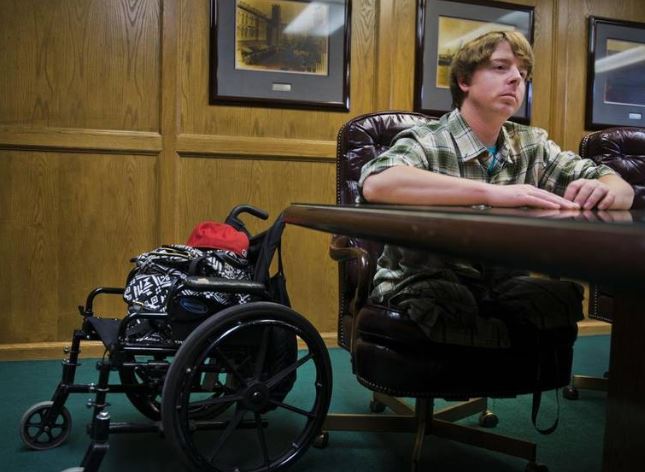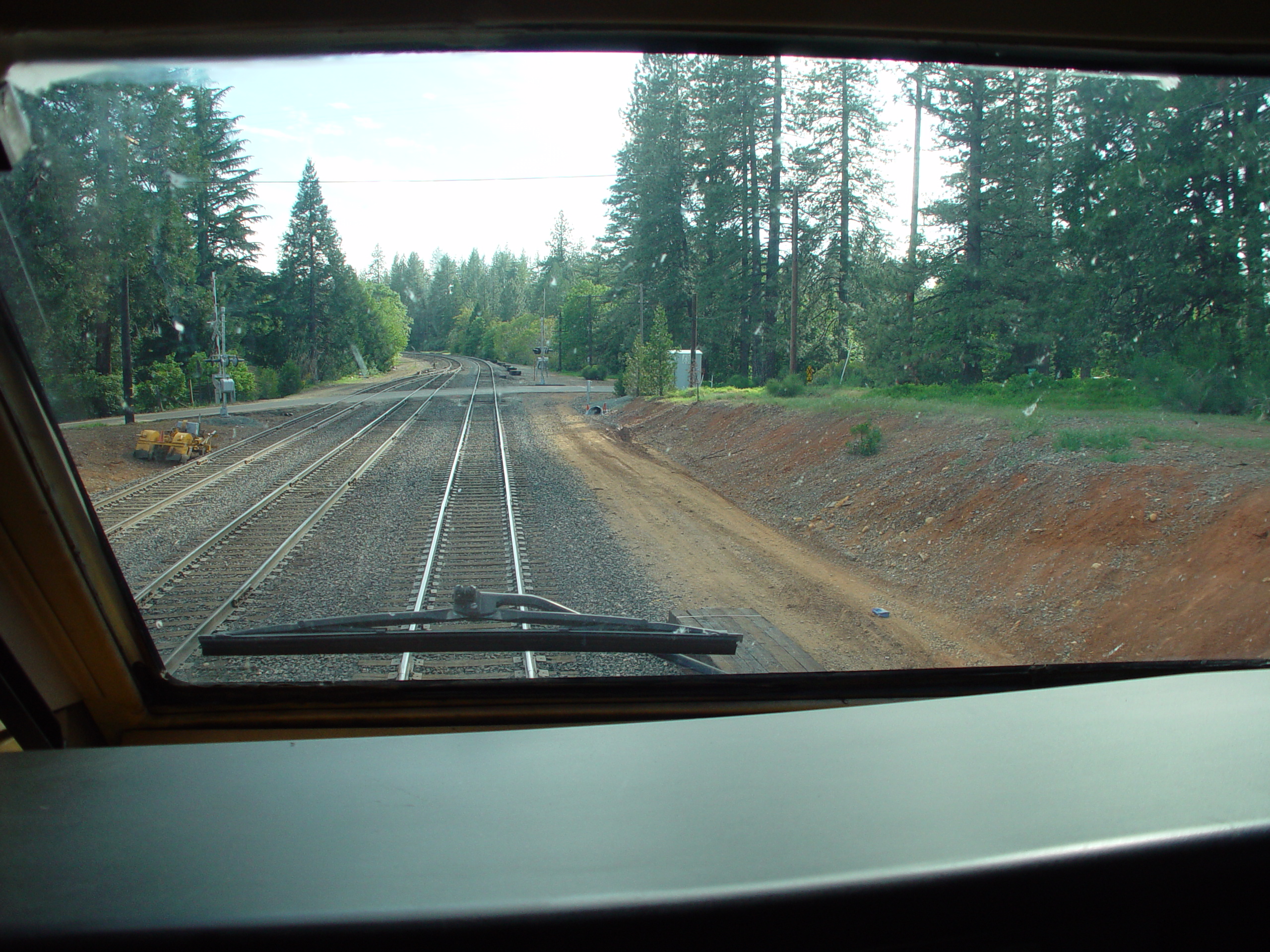Steam locomotives are alive.
BZ

Steam locomotives are alive.
BZ
Steam locomotives are alive. And they are incredibly arcane.
Enjoy.
Imagine having to know all of this.
Now you realize how labor-intensive the railroads were at one time. And why.
BZ
 Therefore Amtrak needs to pay pay pay.
Therefore Amtrak needs to pay pay pay.
Hello, “Earth to Consequences, come in?” Sorry, not receiving. “Ask again later.”
From the Leftist Central Sacramento Bee:
He fell onto the railroad tracks, and woke up without legs
by Sam Stanton
Joe Nevis doesn’t remember much about the early morning hours of last Christmas Eve, when a train rolling through Marysville sliced off both his legs as he lay on the railroad tracks where he had fallen near a park.
“I don’t remember the incident at all,” Nevis, 29, said in an interview this week. “I remember waking up in the pitch black feeling like my legs were numb, like I’ve been walking through snow all day. I couldn’t see my legs… I felt down and felt my shinbone, so I knew something bad had happened.”
There, in the pitch dark, Nevis said, he yelled for help until it became apparent no one could hear him.
“Eventually, I realized nobody was coming to help me, so I fell asleep on this object that I found, and it turned out to be my left leg I slept on that night,” he said.
Wait. How does one not feel one’s legs cut off? And how does one fall asleep on one’s severed leg in the first place?
Right. Because one is laboring under alcohol, drugs or a massive combination of the two that most mortals couldn’t remotely withstand.
Today, Nevis is still recovering from the incident, and has filed a federal negligence lawsuit against Amtrak, Union Pacific Railroad Co. and Marysville’s Rideout Memorial Hospital seeking damages for injuries that will affect him for the rest of his life.
Wait. Did Amtrak place him on the tracks? Did Union Pacific place him on the tracks? Did Marysville’s Rideout Hospital place him on the tracks?
I seem to somehow conveniently forget those parts.
Nevis says he has no memory of how he ended up on the tracks or the hours preceding that, but the lawsuit cites medical and other records – including a video recording of the incident taken by a camera on the train’s lead locomotive – to describe how he went from a healthy young construction worker to a legless man trying to rebuild his life.
Hello? Earth to John Barleycorn?
“What happened next is unknown by Mr. Nevis; what is known is that at some point he consumed alcohol,” the lawsuit says.
Nevis says he can’t recall what happened after that.
For those of us in tune with the rest of the planet, that is labeled a “clue.” C L U E .
According to the lawsuit, Nevis was picked up by local law enforcement officers, who decided he was “too drunk for jail” and took him to Rideout Memorial Hospital, where he was deposited at 1:26 a.m.
He was discharged at 1:56 a.m. without anyone calling to have someone pick him up or have police come get him, the lawsuit says.
Foreshadowing. Just wait.
He wandered into a park, then to a “clearly visible pedestrian path” that the lawsuit says belongs to either Union Pacific or Amtrak.
“At the end of the pedestrian path are a set of mainline railroad tracks,” the lawsuit says. “Mr. Nevis walked across the train tracks to where pedestrian paths enter the park area.
“Mr. Nevis tripped over the tracks and ended up on the back side of the tracks near the park area.”
Then, the train came through.
Is that “pedestrian path” official or unofficial? Is it paved or is it comprised of dirt? Was it maintained or abandoned? A difference it makes.
The train came through.
Gosh. What trains usually do. On tracks. They come through.
The lawsuit says the northbound Amtrak train – which Amtrak schedules indicate would have been the Coast Starlight train to Seattle – passed through at about 2:50 a.m. traveling 25 mph.
Really? What usually occurs at 2:50 AM? Oh, right. Darkness. And lots of it.
“The forward-facing video camera on the passenger train’s lead locomotive shows that Mr. Nevis was clearly visible to anyone inside the locomotive keeping a proper lookout, i.e., being alert and attentive,” the lawsuit says.
The train operators took no action to sound the locomotive’s horn or try to brake, the suit says, and “ran over Mr. Nevis, amputating his left leg above the knee and his right leg below the knee.”
Stop there for just a moment.
If there’s one thing I know it’s the numerous locomotive engineers I’ve contacted during my interest in local railroads in the high Sierra Nevada Mountains. I’ve made friends not only with original Southern Pacific locomotive engineers and conductors, but early Union Pacific locomotive engineers and conductors.
And none of the engineers, having more than a few years of service under their belts, have killed less than one person standing on the tracks in front of them. Some were accidents, and many were suicides. Those times embed themselves into the minds of railroad engineers. That is a terrible price to pay for such a job. Those are terrible wounds to inflict on locomotive cab personnel.
You feel bad for those killed? You should truly feel bad for the engineers who have those mental images embedded upon their brains now and forever.
The train continued on its route and no one reported the incident, the suit says, “either because no one noticed they had run over a human being, or the operators of the train did not believe it was necessary to stop or notify anyone.”
Are you kidding me? These engineers know precisely of what their jobs consist. Their training regimens address that specific issue and many more.
Do you possibly think that any engineer or conductor enjoys injuring or killing people, much less the resulting hours detained by local law enforcement — and the NTSB and the internal investigations conducted by the applicable railroad? In the slightest? Thinking that they can merely “get away” with ignoring the whole affair knowing full well that in-cab cameras are directly in front of their faces?
Engineers on UP tracks, whether they are UP freight or Amtrak passenger trains, are well aware of the speed limits. They are in their timetables and they are posted adjacent the tracks.
 You can see the static view of an Amtrak cab whilst stopped in Dutch Flat. Now imagine this times 25 mph. Now imagine this at night. What is it that you could truly observe? Can you see the crossing ahead in the dark? Can you see something dark obstructing the tracks? Easily seen here. What about at night, at speed?
You can see the static view of an Amtrak cab whilst stopped in Dutch Flat. Now imagine this times 25 mph. Now imagine this at night. What is it that you could truly observe? Can you see the crossing ahead in the dark? Can you see something dark obstructing the tracks? Easily seen here. What about at night, at speed?
Let’s also apply some physics.
One Amtrak GE P42 DC locomotive weighs about 150 tons. The average Amtrak passenger car weights about 65 tons. A train consisting of, let’s say, 10 cars weighs 650 tons plus a minimum of two locomotives. That’s 300 + 650 tons. In general.
“An 8-car passenger train moving at 80 miles an hour needs about a mile to stop.”
An Amtrak train running at roughly 25 mph needs about 1,200 feet to stop without throwing every passenger out of their seats, across aisles, into each other and assorted pieces of equipment and sharp objects inside the cars. Stopping distance for, say, a 2017 Dodge Charger traveling 70 mph is 171 feet. Slight difference.
Let us also remember that the contact patch for each wheel to the rail on a locomotive or a train car is the size of a dime. That’s all you have for traction or adhesion.
Look at the photo above. See the left curve far ahead. That’s about 1,000 feet. At night, at 25 mph, you’d need to start applying your brakes where the locomotive is currently located in order to stop appropriately. That’s if the view is unoccluded and, frankly, I have no insight into the specific spot mentioned in the story. Are there trees and brush nearby? Another curve? Tangent track? Overhead lines? Lights, distractions? I have no idea. But I cannot merely assume that track conditions were perfect. And how do you know what’s debris on the track and what’s human? Should trains be running at 5 mph all the time “in case” someone is on the track, laboring under drugs and/or alcohol?
I suppose non-reality Leftists would say “yes, if we only save one person’s life.”
The lawsuit says Nevis lay on the tracks for six hours, until he was discovered at about 8 a.m. by a motorcycle dirt rider who called 911.
That is a terrible situation but if you’re in an area seldom frequented by anything but trains on the track, it’s understandable. It’s not Amtrak’s job or Union Pacific’s job to check tracks every few hours for obstacles. They are in the business of running trains and moving freight or passengers. Nevis is lucky. He was discovered before he died. Or perhaps before he was possibly struck again by a 10,000-ton UP freight train.
The moment you hear the hiss of air is when the engineer has thrown the passenger train into “emergency” and, even then, it takes over 2,000 feet to stop. This occurred in daylight under ideal conditions and on tangent, unobstructed track.
We live in a litigious society. Granted. But to remove the obvious massive factors that Nevis purposely inserted into the scenario himself is galling at minimum and egregious at best.
Bottom line?
Just like our kids these days, we are no longer expected to perform or act in responsible ways. Our behavior is less and less a factor in terms of determining judgment. It is always someone else’s fault because, well, that’s how we were raised and how we are supported in today’s schools and college campuses.
We can thank helicopter parents for that as well as today’s juries who think: ‘hey, if that was me, wouldn’t I want the cash? Hell yeah, I would.”
You want to see rationality return to civil suits?
Two words:
“Loser pays.”
BZ
A moment away from politics to display one of my railroad videos.
A Union Pacific train westbound over Donner Pass and down towards Roseville, California, on the Roseville Subdivision.
BZ